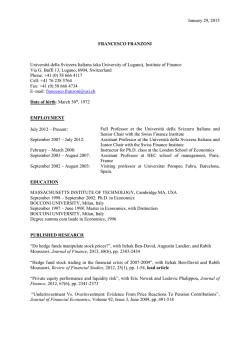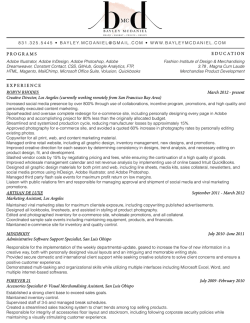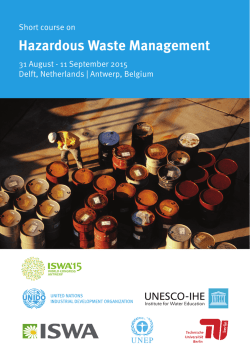
GREENBASE™ HEC Warning - Chevron Phillips Chemical Company
SAFETY DATA SHEET GREENBASE™ HEC Version 2.0 Revision Date 2015-01-29 SECTION 1: Identification of the substance/mixture and of the company/undertaking Product information Product Name Material : : GREENBASE™ HEC 1083673, 1102086 Use : Oil Frac Additive Company : Chevron Phillips Chemical Company LP Drilling Specialties Company LLC 10001 Six Pines Drive The Woodlands, TX 77380 Emergency telephone: Health: 866.442.9628 (North America) 1.832.813.4984 (International) Transport: North America: CHEMTREC 800.424.9300 or 703.527.3887 Asia: +800 CHEMCALL (+800 2436 2255) China:+86-21-22157316 EUROPE: BIG +32.14.584545 (phone) or +32.14583516 (telefax) South America SOS-Cotec Inside Brazil: 0800.111.767 Outside Brazil: +55.19.3467.1600 Responsible Department E-mail address Website : : : Product Safety and Toxicology Group [email protected] www.CPChem.com SECTION 2: Hazards identification Classification of the substance or mixture This product has been classified in accordance with the hazard communication standard 29 CFR 1910.1200; the SDS and labels contain all the information as required by the standard. Emergency Overview Warning Physical state: Liquid OSHA Hazards Color: tan Odor: Slight : Moderate eye irritant Classification MSDS Number:100000013651 1/12 SAFETY DATA SHEET GREENBASE™ HEC Version 2.0 Revision Date 2015-01-29 : Eye irritation , Category 2A Labeling Symbol(s) : Signal Word : Hazard Statements Warning : H319: Causes serious eye irritation. Precautionary Statements : Prevention: P264 Wash skin thoroughly after handling. P280 Wear eye protection/ face protection. Response: P305 + P351 + P338 IF IN EYES: Rinse cautiously with water for several minutes. Remove contact lenses, if present and easy to do. Continue rinsing. P337 + P313 If eye irritation persists: Get medical advice/ attention. Potential Health Effects Aggravated Medical Condition Eyes : Eyes : Causes eye irritation. Carcinogenicity: IARC No ingredient of this product present at levels greater than or equal to 0.1% is identified as probable, possible or confirmed human carcinogen by IARC. No ingredient of this product present at levels greater than or equal to 0.1% is identified as a known or anticipated carcinogen by NTP. No ingredient of this product present at levels greater than or equal to 0.1% is identified as a carcinogen or potential carcinogen by ACGIH. NTP ACGIH SECTION 3: Composition/information on ingredients Synonyms : Hydroxyethyl Cellulose Suspension Molecular formula : Mixture Component Di(Ethylene Glycol) Butyl Ether MSDS Number:100000013651 CAS-No. 112-34-5 Weight % 54 - 65 2/12 SAFETY DATA SHEET GREENBASE™ HEC Version 2.0 Revision Date 2015-01-29 SECTION 4: First aid measures General advice : Consult a physician. In case of eye contact : Remove contact lenses. Rinse immediately with plenty of water, also under the eyelids, for at least 15 minutes. If swallowed : Keep respiratory tract clear. Never give anything by mouth to an unconscious person. If symptoms persist, call a physician. SECTION 5: Firefighting measures Flash point : 100 °C (212 °F) Autoignition temperature : 204 °C (399 °F) Autoignition temperature Suitable extinguishing media : Use water spray, alcohol-resistant foam, dry chemical or carbon dioxide. Specific hazards during fire fighting : Do not use a solid water stream as it may scatter and spread fire. Cool closed containers exposed to fire with water spray. Special protective equipment for fire-fighters : In the event of fire, wear self-contained breathing apparatus. Hazardous decomposition products : Carbon oxides. SECTION 6: Accidental release measures Personal precautions : Use personal protective equipment. Ensure adequate ventilation. Evacuate personnel to safe areas. Keep people away from and upwind of spill/leak. Material can create slippery conditions. Environmental precautions : No special environmental precautions required. Methods for cleaning up : Keep in suitable, closed containers for disposal. Clean contaminated floors and objects thoroughly while observing environmental regulations. Additional advice : No conditions to be specially mentioned. SECTION 7: Handling and storage Handling Advice on safe handling : Avoid contact with skin and eyes. For personal protection see section 8. Smoking, eating and drinking should be prohibited in the application area. Storage MSDS Number:100000013651 3/12 SAFETY DATA SHEET GREENBASE™ HEC Version 2.0 Revision Date 2015-01-29 SECTION 8: Exposure controls/personal protection Ingredients with workplace control parameters US Ingredients Di(Ethylene Glycol) Butyl Ether * Basis Value Control parameters Note ACGIH TWA 10 ppm, *, Inhalable fraction and vapor 2013 Adoption Engineering measures Adequate ventilation to control airborned concentrations below the exposure guidelines/limits. Consider the potential hazards of this material (see Section 2), applicable exposure limits, job activities, and other substances in the work place when designing engineering controls and selecting personal protective equipment. If engineering controls or work practices are not adequate to prevent exposure to harmful levels of this material, the personal protective equipment listed below is recommended. The user should read and understand all instructions and limitations supplied with the equipment since protection is usually provided for a limited time or under certain circumstances. Personal protective equipment Respiratory protection : Wear a supplied-air NIOSH approved respirator unless ventilation or other engineering controls are adequate to maintain minimal oxygen content of 19.5% by volume under normal atmospheric pressure. Wear a NIOSH approved respirator that provides protection when working with this material if exposure to harmful levels of airborne material may occur, such as:. Air-Purifying Respirator for Dusts and Mists / P100. Use a positive pressure, air-supplying respirator if there is potential for uncontrolled release, exposure levels are not known, or other circumstances where air-purifying respirators may not provide adequate protection. Hand protection : The suitability for a specific workplace should be discussed with the producers of the protective gloves. Please observe the instructions regarding permeability and breakthrough time which are provided by the supplier of the gloves. Also take into consideration the specific local conditions under which the product is used, such as the danger of cuts, abrasion, and the contact time. Gloves should be discarded and replaced if there is any indication of degradation or chemical breakthrough. Eye protection : Tightly fitting safety goggles. Skin and body protection : Choose body protection in relation to its type, to the concentration and amount of dangerous substances, and to the specific work-place. Wear as appropriate:. Protective suit. Safety shoes. Hygiene measures : Wash hands before breaks and immediately after handling the product. Remove contaminated clothing and protective equipment before entering eating areas. Protective measures : Wear suitable protective equipment. When using do not eat, drink or smoke. MSDS Number:100000013651 4/12 SAFETY DATA SHEET GREENBASE™ HEC Version 2.0 Revision Date 2015-01-29 SECTION 9: Physical and chemical properties Information on basic physical and chemical properties Appearance Physical state Color Odor : Liquid : tan : Slight Safety data Flash point : 100 °C (212 °F) Lower explosion limit : No data available Upper explosion limit : No data available Oxidizing properties : no Autoignition temperature : Molecular formula : Mixture Molecular weight : Not applicable pH : Not applicable pour point : No data available Boiling point/boiling range : 228 °C (442 °F) Vapor pressure : 0.02 mbar at 20 °C (68 °F) Relative density : 1.1 Water solubility : Soluble Partition coefficient: noctanol/water Viscosity, dynamic : No data available Viscosity, kinematic : No data available Relative vapor density : 9.13 (Air = 1.0) Evaporation rate : 0.01 (N-Butyl Acetate = 1) 204 °C (399 °F) Autoignition temperature : 4.74 mPa.s SECTION 10: Stability and reactivity MSDS Number:100000013651 5/12 SAFETY DATA SHEET GREENBASE™ HEC Version 2.0 Chemical stability Revision Date 2015-01-29 : This material is considered stable under normal ambient and anticipated storage and handling conditions of temperature and pressure. Possibility of hazardous reactions Materials to avoid Hazardous decomposition products Other data : May react with oxygen and strong oxidizing agents, such as chlorates, nitrates, peroxides, etc. : Carbon oxides : No decomposition if stored and applied as directed. SECTION 11: Toxicological information GREENBASE™ HEC Acute oral toxicity GREENBASE™ HEC Acute dermal toxicity : Acute toxicity estimate: 3,708 mg/kg Method: Calculation method : Acute toxicity estimate: 4,252 mg/kg Method: Calculation method Acute toxicity estimate: 4,252 mg/kg Method: Calculation method Skin irritation Di(Ethylene Glycol) Butyl Ether GREENBASE™ HEC Eye irritation : slight irritation. : Eye irritation. Sensitization Di(Ethylene Glycol) Butyl Ether : Did not cause sensitization on laboratory animals. Repeated dose toxicity Di(Ethylene Glycol) Butyl Ether MSDS Number:100000013651 : Species: rat, Male and female Sex: Male and female Application Route: Oral NOEL: 250 mg/kg Lowest observable effect level: 1,000 mg/kg Method: OCED Guideline 408 Target Organs: Blood, Liver, Kidney 6/12 SAFETY DATA SHEET GREENBASE™ HEC Version 2.0 Revision Date 2015-01-29 Species: rat, Male and female Sex: Male and female Application Route: inhalation (vapor) NOEL: 94 mg/m3 Method: OECD Guideline 413 Target Organs: Lungs Species: rat, Male and female Sex: Male and female Application Route: Dermal NOEL: 2,000 mg/kg Target Organs: Skin Reproductive toxicity Di(Ethylene Glycol) Butyl Ether : Species: mouse Sex: male and female Application Route: Oral Dose: 0, 720, 1340, 2050mg/kg bw Number of exposures: continuous Test period: 14 weeks Method: OECD Test Guideline 416 NOAEL Parent: 720 mg/kg NOAEL F1: 720 mg/kg NOAEL F2: 720 mg/kg Information given is based on data obtained from similar substances. Developmental Toxicity Di(Ethylene Glycol) Butyl Ether : Species: rat Application Route: Oral diet Dose: 25, 115, 633 mg/kg/d Number of exposures: GD 0 -20 d Method: OECD Guideline 414 NOAEL Teratogenicity: 633 mg/kg NOAEL Maternal: 633 mg/kg No adverse effects expected Species: rabbit Application Route: Dermal Dose: 25, 115, 633 mg/kg/d Exposure time: 4 h/d Number of exposures: GD 8 -19 d Method: OECD Guideline 414 NOAEL Teratogenicity: 1,000 mg/kg NOAEL Maternal: 1,000 mg/kg No adverse effects expected GREENBASE™ HEC Aspiration toxicity : No aspiration toxicity classification. CMR effects Di(Ethylene Glycol) Butyl Ether MSDS Number:100000013651 : Carcinogenicity: Not available Mutagenicity: Tests on bacterial or mammalian cell cultures did not show mutagenic effects., In vivo tests did not show mutagenic effects 7/12 SAFETY DATA SHEET GREENBASE™ HEC Version 2.0 Revision Date 2015-01-29 Teratogenicity: Animal testing did not show any effects on fetal development. Reproductive toxicity: Animal testing did not show any effects on fertility. SECTION 12: Ecological information Toxicity to fish Di(Ethylene Glycol) Butyl Ether : LC50: > 1,000 mg/l Exposure time: 96 h Species: Scophthalmus maximus (Flatfish, Flounder) semi-static test Method: OECD Test Guideline 203 Toxicity to daphnia and other aquatic invertebrates Di(Ethylene Glycol) Butyl Ether : EC50: > 1,000 mg/l Exposure time: 48 h Species: Acartia tonsa (Marine Copepod) static test Method: ISO TC147/SC5/WG2 Toxicity to algae Di(Ethylene Glycol) Butyl Ether : EC50: > 1,000 mg/l Exposure time: 72 h Species: Skeletonema costatum Growth inhibition Method: ISO 10253 Biodegradability Di(Ethylene Glycol) Butyl Ether : aerobic Result: Readily biodegradable. 76 % This material is expected to be readily biodegradable. Ecotoxicology Assessment Results of PBT assessment Di(Ethylene Glycol) Butyl Ether Additional ecological information : This substance is not considered to be persistent, bioaccumulating nor toxic (PBT)., This substance is not considered to be very persistent nor very bioaccumulating (vPvB). : This material is not expected to be harmful to aquatic organisms. SECTION 13: Disposal considerations The information in this SDS pertains only to the product as shipped. MSDS Number:100000013651 8/12 SAFETY DATA SHEET GREENBASE™ HEC Version 2.0 Revision Date 2015-01-29 Use material for its intended purpose or recycle if possible. This material, if it must be discarded, may meet the criteria of a hazardous waste as defined by US EPA under RCRA (40 CFR 261) or other State and local regulations. Measurement of certain physical properties and analysis for regulated components may be necessary to make a correct determination. If this material is classified as a hazardous waste, federal law requires disposal at a licensed hazardous waste disposal facility. Product : Dispose of wastes in an approved waste disposal facility. SECTION 14: Transport information The shipping descriptions shown here are for bulk shipments only, and may not apply to shipments in non-bulk packages (see regulatory definition). Consult the appropriate domestic or international mode-specific and quantity-specific Dangerous Goods Regulations for additional shipping description requirements (e.g., technical name or names, etc.) Therefore, the information shown here, may not always agree with the bill of lading shipping description for the material. Flashpoints for the material may vary slightly between the SDS and the bill of lading. US DOT (UNITED STATES DEPARTMENT OF TRANSPORTATION) NOT REGULATED AS A HAZARDOUS MATERIAL OR DANGEROUS GOODS FOR TRANSPORTATION BY THIS AGENCY. IMO / IMDG (INTERNATIONAL MARITIME DANGEROUS GOODS) NOT REGULATED AS A HAZARDOUS MATERIAL OR DANGEROUS GOODS FOR TRANSPORTATION BY THIS AGENCY. IATA (INTERNATIONAL AIR TRANSPORT ASSOCIATION) NOT REGULATED AS A HAZARDOUS MATERIAL OR DANGEROUS GOODS FOR TRANSPORTATION BY THIS AGENCY. ADR (AGREEMENT ON DANGEROUS GOODS BY ROAD (EUROPE)) NOT REGULATED AS A HAZARDOUS MATERIAL OR DANGEROUS GOODS FOR TRANSPORTATION BY THIS AGENCY. RID (REGULATIONS CONCERNING THE INTERNATIONAL TRANSPORT OF DANGEROUS GOODS (EUROPE)) NOT REGULATED AS A HAZARDOUS MATERIAL OR DANGEROUS GOODS FOR TRANSPORTATION BY THIS AGENCY. ADN (EUROPEAN AGREEMENT CONCERNING THE INTERNATIONAL CARRIAGE OF DANGEROUS GOODS BY INLAND WATERWAYS) NOT REGULATED AS A HAZARDOUS MATERIAL OR DANGEROUS GOODS FOR TRANSPORTATION BY THIS AGENCY. Transport in bulk according to Annex II of MARPOL 73/78 and the IBC Code MSDS Number:100000013651 9/12 SAFETY DATA SHEET GREENBASE™ HEC Version 2.0 Revision Date 2015-01-29 SECTION 15: Regulatory information National legislation SARA 311/312 Hazards : Acute Health Hazard CERCLA Reportable Quantity : This material does not contain any components with a CERCLA RQ. SARA 302 Reportable Quantity : This material does not contain any components with a SARA 302 RQ. SARA 302 Threshold Planning Quantity : SARA 302: No chemicals in this material are subject to the reporting requirements of SARA Title III, Section 302. SARA 304 Reportable Quantity : This material does not contain any components with a section 304 EHS RQ. SARA 313 Ingredients : SARA 313: This material does not contain any chemical components with known CAS numbers that exceed the threshold (De Minimis) reporting levels established by SARA Title III, Section 313. Clean Air Act Ozone-Depletion Potential : This product neither contains, nor was manufactured with a Class I or Class II ODS as defined by the U.S. Clean Air Act Section 602 (40 CFR 82, Subpt. A, App.A + B). This product does not contain any hazardous air pollutants (HAP), as defined by the U.S. Clean Air Act Section 112 (40 CFR 61). This product does not contain any chemicals listed under the U.S. Clean Air Act Section 112(r) for Accidental Release Prevention (40 CFR 68.130, Subpart F). The following chemical(s) are listed under the U.S. Clean Air Act Section 111 SOCMI Intermediate or Final VOC's (40 CFR 60.489): : Di(Ethylene Glycol) Butyl Ether - 112-34-5 US State Regulations MSDS Number:100000013651 10/12 SAFETY DATA SHEET GREENBASE™ HEC Version 2.0 Revision Date 2015-01-29 Pennsylvania Right To Know : Di(Ethylene Glycol) Butyl Ether - 112-34-5 New Jersey Right To Know : Di(Ethylene Glycol) Butyl Ether - 112-34-5 California Prop. 65 Ingredients : This product does not contain any chemicals known to the State of California to cause cancer, birth, or any other reproductive defects. Notification status Europe REACH United States of America TSCA Canada DSL Australia AICS New Zealand NZIoC Japan ENCS Korea KECI Philippines PICCS China IECSC : : : : : : : : : On the inventory, or in compliance with the inventory On the inventory, or in compliance with the inventory On the inventory, or in compliance with the inventory On the inventory, or in compliance with the inventory On the inventory, or in compliance with the inventory On the inventory, or in compliance with the inventory On the inventory, or in compliance with the inventory On the inventory, or in compliance with the inventory On the inventory, or in compliance with the inventory SECTION 16: Other information NFPA Classification : Health Hazard: 2 Fire Hazard: 1 Reactivity Hazard: 0 1 2 0 Further information Legacy SDS Number : 711520 Significant changes since the last version are highlighted in the margin. This version replaces all previous versions. The information in this SDS pertains only to the product as shipped. The information provided in this Safety Data Sheet is correct to the best of our knowledge, information and belief at the date of its publication. The information given is designed only as a guidance for safe handling, use, processing, storage, transportation, disposal and release and is not to be considered a warranty or quality specification. The information relates only to the specific material designated and may not be valid for such material used in combination with any other materials or in any process, unless specified in the text. Key or legend to abbreviations and acronyms used in the safety data sheet ACGIH AICS American Conference of Government Industrial Hygienists Australia, Inventory of Chemical MSDS Number:100000013651 LD50 Lethal Dose 50% LOAEL Lowest Observed Adverse Effect 11/12 SAFETY DATA SHEET GREENBASE™ HEC Version 2.0 Revision Date 2015-01-29 CNS CAS Substances Canada, Domestic Substances List Canada, Non-Domestic Substances List Central Nervous System Chemical Abstract Service EC50 Effective Concentration NOAEL EC50 EGEST NOEC OSHA GHS Effective Concentration 50% EOSCA Generic Exposure Scenario Tool European Oilfield Specialty Chemicals Association European Inventory of Existing Chemical Substances Germany Maximum Concentration Values Globally Harmonized System >= IC50 Greater Than or Equal To Inhibition Concentration 50% STEL SARA IARC International Agency for Research on Cancer Inventory of Existing Chemical Substances in China Japan, Inventory of Existing and New Chemical Substances Korea, Existing Chemical Inventory TLV Resource Conservation Recovery Act Short-term Exposure Limit Superfund Amendments and Reauthorization Act. Threshold Limit Value TWA Time Weighted Average TSCA Toxic Substance Control Act UVCB <= Less Than or Equal To WHMIS Unknown or Variable Composition, Complex Reaction Products, and Biological Materials Workplace Hazardous Materials Information System LC50 Lethal Concentration 50% DSL NDSL EOSCA EINECS MAK IECSC ENCS KECI MSDS Number:100000013651 Level National Fire Protection Agency NFPA NIOSH National Institute for Occupational Safety & Health National Toxicology Program New Zealand Inventory of Chemicals No Observable Adverse Effect Level No Observed Effect Concentration Occupational Safety & Health Administration Permissible Exposure Limit NTP NZloC PEL PICCS Philippines Inventory of Commercial Chemical Substances Presumed Not Toxic PRNT RCRA 12/12
© Copyright 2025

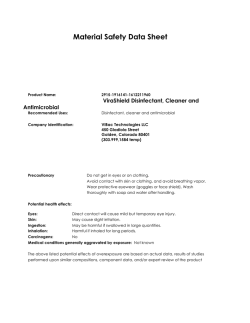
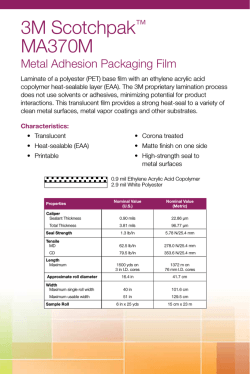

![1 [Billing Code: 4140-01-P] DEPARTMENT OF HEALTH AND](http://s2.esdocs.com/store/data/000481670_1-8e8a4da9fa52328752f9c73fe145ffa0-250x500.png)
